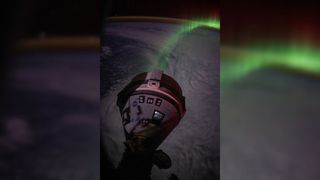New photos and a stunning time-lapse show awe-inspiring scenes fill the scene as Boeing Starliner astronauts perform a crucial in-flight test in space on Saturday (June 15).
Starliner he is currently on International Space Station (ISS), and the crew was testing the capsule’s thrusters because problems had delayed its docking procedures; the first time the issues occurred was June 6, when the astronauts were on board. While this is going on, NASA the astronauts floated into the vicinity SpaceX The Dragon capsule, also attached to the ISS, captured a glowing green aurora behind the Starliner’s rear end.
“The Starliner was testing today, so we decided to check it out from the dragon windows,” NASA astronaut Matthew Dominick wrote on X, formerly Twitter. “The timing was good for the aurora to line up well with the Starliner service module thrusters.” Dominick shared an event time to testin which you can see the torches from the crew lighting up the Starliner.
Auroras it occurs when the sun explodes and sends out charged particles that interact with it magnetic field rotating lines The world. The particles glow and emit bright colors. Know it’s in full swing right now as it peaks in its normal 11-year cycle of activity, which is why these displays have been seen so many times on Earth and in space.
Related: Malfunctions and helium leaks won’t stop Boeing’s Starliner astronaut test flight – but why do they happen?

Starliner is co-piloted by veteran NASA astronauts Butch Wilmore and Suni Williams, both former US Navy test pilots. They have repeatedly stressed that the mission is developmental and is designed to solve major issues before Starliner is fully certified to perform orbital missions to the ISS, starting no earlier than 2025 with Starliner-1.
Because of thruster testing and space travel–on schedule, the team’s expected week-long Crew Flight Test (CFT) mission has doubled to an earlier departure than June 22. NASA will hold a press conference tomorrow (June 18) to discuss the mission’s progress.
During the extended mission, “crews will conduct additional hatch operations to better understand how it handles, repeat ‘safe haven’ tests and evaluate tests using the front window,” said Steve Stich, manager of NASA’s Enterprise Crew Program. , said in latest agency information.
Related: ‘I’m sure we’ll figure things out’: NASA astronauts jump to launch website for first Boeing Starliner crewed mission to ISS
Starliner and Dragon are two commercial spacecraft that NASA funded in 2014 for astronaut missions to the ISS. At the time, both spacecraft were expected to fly no earlier than 2017. However, technical and funding problems delayed that goal. SpaceX sent its first astronauts aloft in 2020 after an unmanned test flight, with the Starliner waiting longer.
Starliner’s first ISS launch in 2019 failed to reach its destination due to computer errors. Many such issues and the outbreak of the coronavirus pandemic in 2020 delayed the second test which has not been carried out until 2022. The test was planned, but new problems arose. For example, there were problems with parachute loading and flammable tape that delayed the launch of the CFT until 2023.
The launch of CFT was then delayed by an additional monthfrom May 6 to June 5. This was due to various issues and United Launch Alliance An Atlas V rocket, with a small helium leak in one of the Starliner launchers. The leak, among other issues, affected one re-entry route Earth environment and required careful evaluation before a successful launch.
#Shine #Starliner #Aurora #glows #green #astronauts #test #spacecraft #returning #Earth #June #photos #video